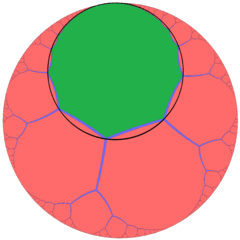Horocycle



In hyperbolic geometry, a horocycle (Greek: ὅριον + κύκλος — border + circle) is a curve whose normal geodesics all converge asymptotically. (It is also called an oricycle or oricircle, and a limit circle.) It is the two-dimensional example of a horosphere (or orisphere).
A horocycle can also be described as the limit of the circles that share a tangent in a given point, as their radii go towards infinity. In ordinary Euclidean geometry, such a "circle of infinite radius" would be a straight line, but in hyperbolic geometry it is a curve.
From the convex side the horocycle is approximated by hypercycles whose distances from their axis go towards infinity.
Representations in models of hyperbolic geometry
In the Poincaré disk model of the hyperbolic plane, horocycles are represented by circles tangent to the boundary circle.
In the Poincaré half-plane model, horocycles are represented by circles tangent to the boundary line, and lines parallel to the boundary line.
In the hyperboloid model they are represented by intersections of the hyperboloid with planes whose normal lies in the asymptotic cone.
Metric
If the metric is normalized to have Gaussian curvature −1, then the horocycle is a curve of geodesic curvature 1 at every point.
See also
References
- H. S. M. Coxeter (1961) Introduction to Geometry, §16.6: "Circles, horocycles, and equidistant curves", page 300, 1, John Wiley & Sons.
- Four Pillars of Geometry p.198